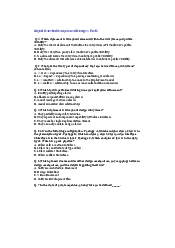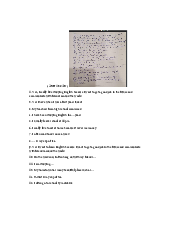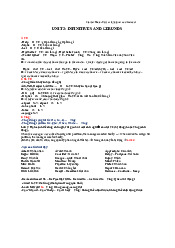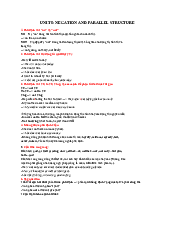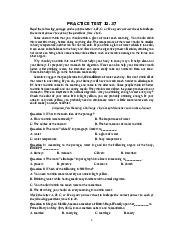



Preview text:
I. Pronunciation (1 point) 1. a. works b. shifts c. stops d. play s 2. a. talks
b. discovers c. drives d. studie s 3. a. played b. arrived c. watched d. obtained 4. a. attracted b. decided c. expected d. engaged 5. a. house b. shower
c. daughter (0)d. how (a)
II. Language Review (3 points) Chose the best answer
1. I have a nephew (cháu trai )in the US. She / He / It is a cook in a hotel.
2. She is from ( 1 quốc gia) Argentinian / Australian / Brazil.
3. My parents don’t cook / aren’t cook / doesn’t cooking every Sunday. They often eat out.
4. My son doesn’t like school days at all because he has to wear a / an / the uniform.
5. Do / Can / Is he play the guitar?
6. Would you like ( lời mời )any / some / an orange juice?
7. Do / Does / Are you like watching T.V?
8. There are much / many / a little apples left in the fridge.
9. Mary is American ( người mỹ)/ America ( nước Mỹ) / Vietnam.
10. My son sometimes takes / gets / washes a hot shower at 7 o’clock.
11. I often go on a / an / the Internet to search documents.
12. Roosters often crow on / in / at 3:00 a.m.
13. Ho Chi Minh City is the biggest / most big / bigger city in Vietnam.
14. “Whose is that car?” - “It’s mine / she / me”.
15. I’d like ( to V) playing / to play / play soccer after class. III. Writing (1 point)
1. He like reading books What does He like doing?
2. My sister lives in HaNoi Where does your sister like? 3. There are three flower s on the desk
How many ( phải có danh từ) flowers there are on the desk?
4. I visited my grandmom yesterday
When did you visit your grandmom?
5. My father gave a bike on my birthday
What did your father give you on your birthday?
6. I go to the movie once a month
How often do you go to the movie?
Page 1 of Test 1 - English For Foundation Course
IV. Everyday English (1 point)
Complete the conversation with the words in the box. better majoring interesting interested having meeting like study
A: "Hi Steve. What are you doing here?" B: "I'm (1
a friend here for dinner. How about you?" )… meeting …..
A: "I'm on my way home but I needed to stop by the book store to buy a text book."
B: "Didn't you finish school yet?"
A: "I have one more year, and then I'm done."
B: "What are you (2)… majoring.. in?" A: "I'm studying in Sociology" B: "How do you (3 your major?" )…like…..
A: "I really find the subject very (4)… interested …... I'm enjoying all my classes." B: "That's great." A: "I'd (5
….. go now. I don't want to miss the bus." )……better
B: "Alright, I'll talk to you later." A: "Okay. See you later." V. Reading (2 points)
Read the short text and chose the best answer
American Sign Language (ASL), which is the first language of many deaf people in North
America, uses hand gestures, facial expressions, and other body movements to communicate. ASL
is one of the four most commonly used languages in the United States.
ASL was first introduced to America in 1817. In that year, a French teacher who came to
America to teach brought with him French Sign Language (FSL) and taught it to his deaf students.
The students then added their own American signing and changed the FSL into the ASL. Modern
ASL and FSL share some elements, including a large amount of vocabulary. However, an ASL user cannot understand an FSL user.
No form of sign language is universal. For example, British Sign Language (BSL) differs
notably from ASL. Different sign languages are used in different countries and regions.
1. Which of the following statements is NOT true?
A). Deaf people use different sign languages in different countries and regions.
B). A French teacher introduced FSL to Americans. Answers
C). People who use ASL can understand those who use FSL. 1
D). The deaf use their body movements to communicate. 2
2. How did people change the FSL into the ASL? 3 A). vocabulary was added B). native signing was added 4 C). hand gestures were added
D). American language was added
3. How many commonly used languages are there in the US? A). 4 B). 1 C). 3 D). 2
4. What is the main idea of this passage?
A). The way deaf people communicate.
B). The differences between FSL and BSL.
C). Sign languages for deaf people.
D). How ASL was introduced to America.
